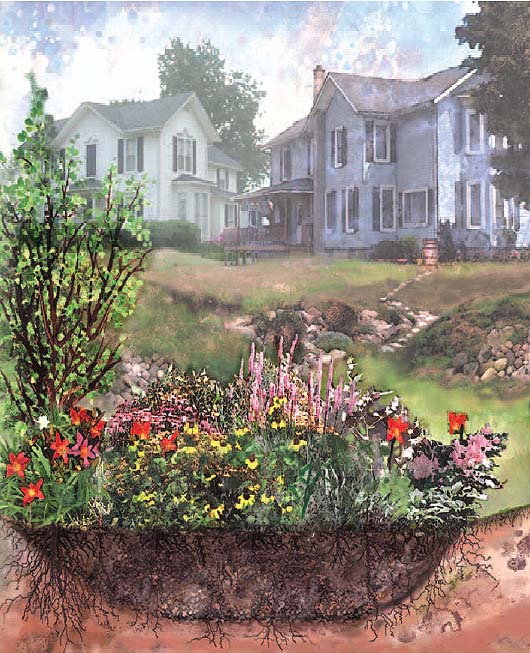April showers bring May flowers! So far 2009 has had above average snow and rainfall amounts. We all remember the 100-year rain last summer, and somehow we can remember the other 100-year rain the previous August!

Source: www.raingardens.org. Artist: Ruth Zachary.
RAIN GARDENS
A new technique of putting a garden bed in a low area to accumulate and filter water has been steadily gaining popularity. As cities and suburbs grow and replace open land with buildings and paved surfaces, the increased stormwater runoff from impervious surfaces becomes more and more of a problem. A low spot in your yard may hold the key to a new gardening adventure as well as a great way to help the environment.
What makes a garden a Rain Garden?
- A rain garden will have a depression in the middle to hold rain water. The depth of the depression should range from 2” to 6”. A rain garden is NOT a pond. Its purpose is to collect water and allow it to soak into the soil. It will be dry for many days at a time; because of this mosquitoes will not be able to breed.
- The depression should have gently sloping sides so plants will naturalize.
- Rain gardens are in area that rain already drains to, or an area down slope from your downspouts or sump pump outlet. It should slope away from your house so overflow will never flood your foundation. Through proper siting and sizing, a rain garden can collect and filter runoff from your roof. It can keep water where it should be– back into the earth, NOT into your basement! It is important to think about what type of soil your property has. Is it sandy, silty or clay? Sandy soil which drains quickly feels gritty and coarse when touched. Silty soils are smooth but not sticky, and drain moderately. Finally, if the soil is sticky and drains poorly it is clay. This will influence the size of your garden. The less well-drained your soil, the larger the garden should be.
- You also need to consider the amount of water you want to collect. How big is your roof? Do you realize how many gallons of water are shed in every rain? To calculate storm water runoff from your roof, multiply length in feet times width in feet of your building, times rainfall feet (inches divided by 12). This is your volume. Take this number and multiply by 7.48 to determine number of storm water gallons per year.
- Example: You reside in Chicago in a house with have a 40’ x 40’ roof,. The overall average rainfall for Chicago is 37”.Take 37 / 12= 3.08. Then take 3.08 x 1600= 4,933 cu. ft. Then multiply 4933 x 7.48 gal/cu. ft.= 36,901 gallons of storm water per year.
- Besides Nature’s Perspective, a great source for specific information about rain gardens is University of Wisconsin-Extension Publication: Rain Gardens: A Manual for Homeowners.
- Rain gardens use moisture-loving plants to absorb storm water. There are many plants that thrive in wet places. Many of our native plants have evolved in wet sites. Many of these have been cultivated and selected to improve bloom size and time. The following is a list of plants we would use in this situation.
|
Native to Illinois: Aronia Chokeberry Asclepias tuberosa Butterfly Weed Aster Flat-Topped Aster (native) Baptisia False Indigo Calamagrostis Blue Joint Grass (native) Carex Sedge (native) Chelone lyonii Pink Turtlehead (native) Glyceria Fowl Manna Grass (native) Lobelia cardinalis Cardinal Flower Eupatorium maculatum Joe Pye Weed Mertensia Virginia Bluebells Rudbeckia Sweet Blackeyed Susan Solidago Goldenrod (native) Veronia Ironweed (native) Zizzia Golden Alexander (native) |
Non-Native to Illinois: Astilbe Acoris Sweet Flag Baptisia False Indigo Boltonia Doll’s Daisy Calycanthus Carolina Allspice Ilex Inkberry Iris Blue Flag Iris Ligularia Penstemon Beardstongue Itea Virginia Sweetspire Clethra Sweetshrub Myrica Bayberry Cornus Dogwood Salix Willow, Dwarf Species |
If you have drainage problems, or are interested in this eco-friendly idea, let us know.
UNDERGROUND STORMWATER STORAGE SYSTEMS
Another new idea that has been developed is one that captures and stores large amounts of rainwater below ground in storage tanks for later use on your garden. This is an attractive alternative to above-ground, unsightly and insufficient rain barrels and cisterns that are often limited in storage capacity.
Several manufacturers have developed systems to do this, such as the Rain Xchange System from St. Charles-based company, Aquascape:
 Aquascape, Inc.
Aquascape, Inc.
A portion of your patio is installed with permeable pavers, allowing water to run down through the patio and into a storage tank. Downspouts are also routed to the tank as well as any excess ground water. Then a pump system is utilized to bring the water back up to where you desire. A water feature or small waterfall is attached, or simply hooked up to your garden hose to a bib for nutrient-rich watering.
Full system components include downspout filters to capture and screen out debris, connecting pipes to channel the water away, gravel to situate the matrix in, check and fill valves and other fittings specific to your installation.
Landscape designers and construction experts here at Nature’s Perspective are excited to discuss this practical new option that beautifies your space while working in harmony with nature’s cycles. We look forward to assisting you with installation.
For further information on underground stormwater storage systems, please contact us at 847-475-7917, and visit www.naturesperspective.com, www.aquascapeinc.com, and www.epa.gov.
